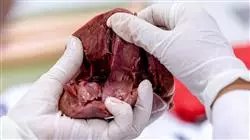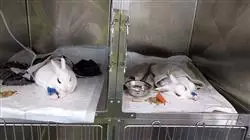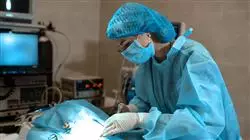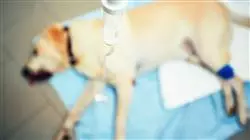University certificate
The world's largest faculty of veterinary medicine”
Why study at TECH?
This training is the best option you can find to specialize in veterinary cardiology and make more accurate diagnoses"

Cardiology of Small Animals is a subspecialty of Internal Medicine with a great development in the last decades. The teachers of this Postgraduate diploma are at the forefront of the latest diagnostic techniques and treatment of cardiovascular diseases in small animals. Thanks to their specialized training, they have developed a useful, practical program adapted to the current reality, a reality that is becoming more and more demanding.
This comprehensive program compiles the different cardiovascular diseases affecting small animals. It starts with a solid development of the basics of cardiovascular physiology, pathophysiology and pharmacology, so often forgotten and so important and useful in daily clinical practice, followed by the optimization of clinical examination and diagnostic tests, and ending with the latest therapeutic protocols and patient monitoring procedures.
This training specializes the general practitioner in an area that is increasingly in demand, partly because of its frequency, partly because of the need for specialization that this area demands
In all the modules, a gradual exposition of physiological and pathophysiological knowledge has been established, a development of the protocols for approaching patients with cardiovascular diseases with diagnostic and treatment algorithms, as well as the monitoring that should be done in these patients, since many of these diseases are chronic. It compiles the author's experience, without forgetting scientific rigor and the most important updates based on evidence. It develops the diseases, the action protocols and takes into account the integral approach to the patient, considering the disease, the patient and the owner in line with evidence-based medicine
All topics incorporate numerous multimedia material: photos, videos and diagrams, so important in a specialty where imaging techniques are of great importance. Finally, as it is an online program, the students are not conditioned by fixed schedules, nor do they need to move to another physical location. All of the content can be accessed at any time of the day, so you can balance your working or personal life with your academic life.
Don't miss the opportunity to study this Postgraduate diploma with us. It's the perfect opportunity to advance your career and stand out in an industry with high demand for professionals”
This Postgraduate diploma in Heart Diseases in Small Animals contains the most complete and up-to-date educational program on the market. The most important features of the program include:
- The development of case studies presented by experts in Heart Diseases in Small Animals
- The graphic, schematic, and eminently practical contents with which they are created, provide scientific and practical information on the disciplines that are essential for professional practice
- New developments in Heart Diseases in Small Animals
- Practical exercises where the self-assessment process can be carried out to improve learning
- Special emphasis on innovative methodologies in Heart Diseases in Small Animals
- Theoretical lessons, questions to the expert, debate forums on controversial topics, and individual reflection work
- Content that is accessible from any fixed or portable device with an Internet connection
This Postgraduate diploma is the best investment you can make in selecting a refresher program to update your veterinary knowledge in cardiology"
The multimedia content, developed with the latest educational technology, will provide the professional with situated and contextual learning, i.e., a simulated environment thatwill provide an immersive program programmed to train in real situations.
This program is designed around Problem-Based Learning, whereby the specialist must try to solve the different professional practice situations that arise during the academic year. For this purpose, the professional will be assisted by an innovative interactive video system created by renowned experts with extensive experience in Heart Diseases in Small Animals.
This training comes with the best didactic material, providing you with a contextual approach that will facilitate your learning"

This 100% online program's degree will allow you to combine your studies with your professional work while increasing your knowledge in this field"
Syllabus
The structure of the content has been designed by the best professionals in the Heart Diseases in Small Animals sector, with extensive experience and recognized prestige in the profession, backed by the volume of cases reviewed, studied, and diagnosed, and with extensive knowledge of new technologies applied to veterinary medicine.

This Postgraduate diploma contains the most complete and up-to-date scientific program on the market"
Module 1. Acquired Heart Diseases Chronic Mitral and Tricuspid Valve Disease Endocarditis Pericardial Alterations Cardiac Masses
1.1. Chronic Degenerative Valve Disease I. Etiology
1.1.1. Valvular Anatomy
1.1.2. Etiology
1.1.3. Prevalence
1.2. Chronic Degenerative Valve Disease II. Pathology
1.2.1. Pathophysiology
1.2.2. Staging and Classification
1.3. Chronic Degenerative Valve Disease III. Diagnosis
1.3.1. History and Exploration
1.3.2. Radiology
1.3.3. Electrocardiogram (ECG)
1.3.4. Echocardiography
1.3.5. Biochemical Tests
1.3.6. Differential Diagnoses
1.4. Chronic Degenerative Valve Disease III. Echocardiographic Assessment
1.4.1. Valvular Anatomy
1.4.1.1. Appearance and Movement
1.4.1.2. Degenerative Lesions
1.4.1.3. Prolapses
1.4.1.4. Ruptured Chordae Tendineae
1.4.2. Dimensions and Functionality of the Left Ventricle
1.4.3. Quantification of Regurgitation
1.4.4. Echocardiographic Staging
1.4.4.1. Cardiac Remodeling
1.4.4.2. Regurgitation Flows and Fraction
1.4.4.3. Left Atrial Pressures
1.4.4.4. Pulmonary Hypertension
1.5. Chronic Degenerative Valve Disease IV. Progression and Decompensation Risk Analysis
1.5.1. Risk Factors for Progression
1.5.2. Decompense Prediction
1.5.3. Particularities in the Evolution of Tricuspid Pathology
1.5.4. Owner's Role
1.5.5. Periodicity of Revisions
1.6. Chronic Degenerative Valve Disease V. Therapies
1.6.1. Medical Treatment
1.6.2. Surgical Management
1.7. Chronic Degenerative Valve Disease VI. Complicating Factors
1.7.1. Arrhythmias
1.7.2. Pulmonary Hypertension
1.7.3. Systemic Arterial Hypertension
1.7.4. Renal Insufficiency
1.7.5. Atrial Rupture
1.8. Infectious Endocarditis
1.8.1. Aetiology and Pathophysiology of Bacterial Endocarditis
1.8.2. Diagnosis of Bacterial Endocarditis
1.8.3. Treatment of Bacterial Endocarditis
1.9. Pericardial Alterations
1.9.1. Pericardium Anatomy and Physiology
1.9.2. Pathophysiology of Pericardial Tamponade
1.9.3. Diagnosis of Pericardial Tamponade
1.9.4. Types of Pericardial Alterations
1.9.4.1. Hernias and Defects
1.9.4.2. Spills or Effusions (Types and Origins)
1.9.4.3. Masses
1.9.4.4. Constrictive Pericarditis
1.9.5. Pericardiocentesis and Protocol of Action
1.10. Cardiac Masses
1.10.1. Aortic Base Tumors
1.10.2. Hemangiosarcoma
1.10.3. Mesothelioma
1.10.4. Intracavitary Tumors
1.10.5. Clots: Atrial Rupture
Module 2. Acquired Heart Diseases Cardiomyopathies
2.1. Primary Canine Dilated Cardiomyopathy
2.1.1. Definition of Primary Dilated Cardiomyopathy (DCM) and Histological Features
2.1.2. Echocardiographic Diagnosis of DCM
2.1.3. Electrocardiographic Diagnosis of Occult DCM
2.1.3.1. Electrocardiogram (ECG)
2.1.3.2. Holter
2.1.4. RCM Therapy
2.1.4.1. Hidden Phase
2.1.4.2. Symptomatic Phase
2.2. Secondary Canine Dilated Cardiomyopathy
2.2.1. Aetiological Diagnosis of Dilated Cardiomyopathy (DCM)
2.2.2. DCM Secondary to Nutritional Deficiencies
2.2.3. DCM Secondary to Other Causes
2.2.3.1. Endocrine Disorders
2.2.3.2. Toxins
2.2.3.3. Others
2.3. Tachycardia-Induced Cardiomyopathy (TICM)
2.3.1. Electrocardiographic Diagnosis of TICM
2.3.1.1. Electrocardiogram (ECG)
2.3.1.2. Holter
2.3.2. TICM Therapy
2.3.2.1. Pharmacotherapy
2.3.2.2. Radiofrequency Ablation
2.4. Arrhythmogenic Right Ventricular Cardiomyopathy (ARVC)
2.4.1. Definition of ARVC and Histological Features
2.4.2. Echocardiographic Diagnosis of ARVC
2.4.3. Electrocardiographic Diagnosis of ARVC
2.4.3.1. ECG
2.4.3.2. Holter
2.4.4. ARVC Therapy
2.5. Feline Hypertrophic Cardiomyopathy (HCM) I
2.5.1.Definition of HCM and Histological Features
2.5.2. Echocardiographic Diagnosis of HCM Phenotype
2.5.3. Electrocardiographic Findings at HCM
2.6. Feline Hypertrophic Cardiomyopathy (HCM) II
2.6.1. Aetiological Diagnosis of HCM
2.6.2. Hemodynamic Consequences of HCM
2.6.3. Staging of HCM
2.6.4. Prognostic Factors in HCM
2.6.5. HCM Therapy
2.6.5.1. Asymptomatic Phase
2.6.5.2. Symptomatic Phase
2.7. Other Feline Cardiomyopathies I
2.7.1. Restrictive Cardiomyopathy (RCM)
2.7.1.1. Histological Characteristics of RCM
2.7.1.2. Echocardiographic Diagnosis of RCM Phenotype
2.7.1.3. Electrocardiographic Findings in RCM
2.7.1.4. RCM Therapy
2.7.2. Feline Dilated Cardiomyopathy
2.7.2.1. Histological Features of Feline Dilated Cardiomyopathy (DCM)
2.7.2.2. Echocardiographic Diagnosis of the DCM Phenotype
2.7.2.3. Etiologic Diagnosis of Feline DCM
2.8. Other Feline Cardiomyopathies II
2.8.1. Feline Dilated Cardiomyopathy (DMC) (cont.)
2.8.1.1 Therapy of Feline DCM
2.8.2. End-stage Cardiomyopathies
2.8.2.1 Echocardiographic Diagnosis
2.8.2.2 Therapy of End-stage Cardiomyopathy
2.8.3 Hypertrophic Obstructive Cardiomyopathy (HOCM)
2.9. Myocarditis
2.9.1. Clinical Diagnosis of Myocarditis
2.9.2. Etiologic Diagnosis of Myocarditis
2.9.3. Non-etiologic Therapy of Myocarditis
2.9.4. Chagas Disease
2.10. Other Myocardial Alterations
2.10.1. Atrial Standstill
2.10.2. Fibroendoelastosis
2.10.3. Cardiomyopathy Associated with Muscular Dystrophy (Duchenne)
2.10.4. Cardiomyopathy in Exotic Animals
Module 3. Congenital Heart Disease
3.1. Patent Ductus Arteriosus (PDA) I
3.1.1. Embryological Mechanisms that Give Rise to PDA
3.1.2. Anatomical Classification of PDA
3.1.3. Echocardiographic Diagnosis
3.2. Patent Ductus Arteriosus II
3.2.1. Pharmacotherapy
3.2.2. Interventional Therapy
3.2.3. Surgical Therapies
3.3. Pulmonary Stenosis (PS) I
3.3.1. Anatomical Classification of PS
3.3.2. Echocardiographic Diagnosis of PS
3.3.3. Pharmacotherapy
3.4. Pulmonary Stenosis II
3.4.1. Interventional Therapy
3.4.2. Surgical Therapies
3.5. Aortic Stenosis (AS) I
3.5.1. Anatomical Classification of AS
3.5.2. Echocardiographic Diagnosis of AS
3.5.3. Pharmacotherapy
3.6. Aortic Stenosis II
3.6.1. Interventional Therapy
3.6.2. Screening Program Results
3.7. Ventricular Septal Defects (VSD)
3.7.1. Anatomical Classification of VSD
3.7.2. Echocardiographic Diagnosis
3.7.3. Pharmacotherapy
3.7.4. Surgical Therapies
3.7.5. Interventional Therapy
3.8. Interatrial Septal Defects (ISD)
3.8.1. Anatomical Classification of ISD
3.8.2. Echocardiographic Diagnosis
3.8.3. Pharmacotherapy
3.8.4. Interventional Therapy
3.9. Atrioventricular Valve Dysplasia
3.9.1. Tricuspid Dysplasia
3.9.2. Mitral Dysplasia
3.10. Other Congenital Defects
3.10.1. Tetralogy of Fallot
3.10.2. Persistent Left Cranial Vena Cava
3.10.3. Double Chamber Right Ventricle
3.10.4. Aorto-Pulmonary Window
3.10.5. Persistent Right Fourth Aortic Arch
3.10.6. Cortriatrium Dexter and Cortriatrium Sinister
3.10.7. Common Atrioventricular Canal
Module 4. Pulmonary and Systemic Hypertension, Systemic Diseases with Cardiac Repercussions and Anesthesia in the Cardiac Patient
4.1. Pulmonary Hypertension (PH) I
4.1.1. Definition of PH
4.1.2. Echocardiographic Diagnosis of PH
4.1.3. PH Classification
4.2. Pulmonary Hypertension II
4.2.1. Additional Diagnostic Protocol in Animals Suspected of PH
4.2.2. PH Treatment
4.3. Systemic Hypertension I
4.3.1. Methods for Blood Pressure Measurement
4.3.2. Diagnosis of Hypertension
4.3.3. Pathophysiology of Systemic Hypertension
4.3.4. Assessment of Target Organ Damage
4.3.5. Hypertensive Cardiomyopathy
4.4. Systemic Hypertension II
4.4.1. Patient Selection for Hypertension ScreeningPrograms
4.4.2. Treatment of Systemic Hypertension
4.4.3. Monitoring of Treatment and Additional Target Organ Damage
4.5. Filariasis
4.5.1. Etiological Agent
4.5.2. Diagnosis of Filarial Infection
4.5.2.1. Physical Methods
4.5.2.2. Serological Methods
4.5.3. Pathophysiology of Filarial Infestations
4.5.3.1. Dogs
4.5.3.2. Cats
4.5.4. Echocardiographic Findings
4.5.5. Treatment of Filariasis
4.5.5.1. Medical Treatment
4.5.5.2. Interventional Treatment
4.6. Endocrine Diseases Affecting the Heart I
4.6.1. Hyperthyroidism
4.6.2. Hypothyroidism
4.6.3. Hyperadrenocorticism
4.6.4. Hypoadrenocorticism
4.7. Endocrine Diseases Affecting the Heart II
4.7.1. Diabetes
4.7.2. Acromegaly
4.7.3. Hyperaldosteronism
4.7.4. Hyperparathyroidism
4.8. Other Systemic Alterations Affecting the Cardiovascular System I
4.8.1. Pheochromocytoma
4.8.2. Anaemia
4.8.3. Uremia
4.8.4. Toxics and Chemotherapeutics
4.8.5. Shock.
4.9. Other Systemic Alterations Affecting the Cardiovascular System II
4.9.1. Gastric Dilatation/Torsion
4.9.2. Splenic Splenitis/Neoplasia
4.9.3. Hypercoagulable State and Thrombosis
4.9.4. Conditions Causing Hypo- or Hypercalcemia
4.9.5. Conditions Causing Hypo- or Hyperkalemia
4.9.6. Conditions Causing Hypo- or Hypermagnesemia
4.10. Anesthesia in Cardiac Patients
4.10.1. Pre-Surgery Assessment
4.10.2. Hemodynamic and Surgical Factors Involved in the Choice of Hypnotics
4.10.3. Anesthetic Monitoring

Achieve professional success with this high-level training provided by prestigious professionals with extensive experience in the sector"
Postgraduate Diploma in Heart Diseases in Small Animals
The veterinary work makes it easier for animals to maintain a healthy lifestyle, to achieve this purpose it is necessary to perform periodic controls that help prevent, diagnose and treat diseases or injuries such as cardiovascular diseases. For this reason, veterinarians refrsh their knowledge to be fully qualified at the time of treating different species. To meet this educational need, at TECH we have developed a Postgraduate Diploma in Heart Diseases in Small Animals; a postgraduate program that will allow you to make accurate diagnoses to treat problems such as arrhythmias, coronary arteries and congenital heart defects. By developing this high-level educational program, you will specialize in the diagnosis of the etiological causes that can generate a cardiomyopathy phenotype. In addition, you will delve into the comprehensive approach of veterinary cardiology used to assess and intervene patients with pericardial effusion, bacterial endocarditis or pericardial alterations. In this way, you will learn in depth the most up-to-date interventional techniques in the sector, which will allow you to improve your professional practice in this field.
Obtain a Postgraduate Diploma at the world's largest School of Veterinary Medicine
At TECH we have high-level programs that will help you meet your academic goals and enhance your professional profile. You will have continuous support from experts in the field, who will guide your process so that you can complete the program with the best study methodologies. By taking this six-month postgraduate program, you will be able to approach clinical research from the most up-to-date scientific positions. You will be able to learn new methods to develop diagnoses of chronic degenerative valve disease, and in turn, consolidate the phenotypic characteristics that define each of the cardiomyopathies that affect these animals. This will allow you to define the most appropriate treatment and therapies to treat this type of problems. Likewise, you will specialize in determining the possible hemodynamic consequences derived from cardiomyopathies, necessary to develop an individualized treatment plan to help improve the quality of life of patients. You will learn the principles of physiology, pathophysiology and cardiovascular pharmacology used in daily clinical practice, which will help you to establish therapeutic protocols suitable for patient follow-up. All this will facilitate the analysis of the embryological mechanisms that give rise to the most frequent congenital alterations.







